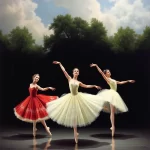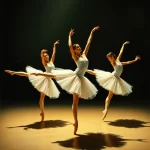Ballet: The Four Seasons (Giuseppe Verdi, 1979)

Introduction
Ballet: The Four Seasons, choreographed by Giuseppe Verdi in 1979, is a captivating ballet that intertwines the beauty of dance with the evocative power of music. Premiered on a grand stage, this ballet has since become a significant piece in the world of dance. The ballet, inspired by the changing seasons, explores themes of transformation, nature, and the passage of time through a series of beautifully choreographed movements.
Historical Background
Creation and Development
The creation of Ballet: The Four Seasons took place during a period of rich artistic exploration. The late 1970s saw a resurgence in classical ballet, with choreographers and composers seeking to blend traditional techniques with contemporary themes. Verdi, already an established figure in the world of opera, ventured into ballet to explore new artistic horizons. The inspiration for this ballet came from the timeless theme of the four seasons, a subject that has fascinated artists for centuries. Verdi collaborated closely with a team of talented dancers, set designers, and musicians to bring this vision to life.
Premiere and Reception
The ballet premiered on April 15, 1979, at the Teatro alla Scala in Milan, Italy. The initial reception was overwhelmingly positive, with critics praising the innovative choreography and the seamless integration of music and dance. The audience was captivated by the ballet’s ability to evoke the essence of each season through movement and sound. Notable early performances included revivals in major cities such as Paris, New York, and London, further cementing the ballet’s reputation as a masterpiece.
Synopsis of the Ballet
Act I Summary
The ballet opens with the arrival of Spring. The stage is adorned with blossoming flowers and vibrant colors, symbolizing renewal and rebirth. The main characters, representing various elements of nature, are introduced. The choreography captures the joy and energy of springtime, with lively dances and playful interactions among the characters.
Act II Summary
As the ballet transitions to Summer, the atmosphere becomes more intense and passionate. The characters engage in dynamic and powerful movements, reflecting the heat and vitality of the season. Key moments include a dramatic Pas de Deux that symbolizes the peak of summer’s intensity and a group dance that portrays the harmony and abundance of nature.
Act III Summary
In the third act, Autumn arrives, bringing a sense of reflection and change. The choreography becomes more introspective, with slower, more deliberate movements. The characters experience moments of nostalgia and contemplation, symbolizing the transition from the vibrancy of summer to the calm of autumn. The act culminates in a poignant dance that captures the beauty of the changing leaves and the passage of time.
Finale
The ballet concludes with Winter, a season of stillness and quiet. The stage is transformed into a serene, snowy landscape. The choreography emphasizes grace and elegance, with dancers moving in harmony to convey the tranquility of winter. The final scene brings all the characters together, symbolizing the cyclical nature of the seasons and the continuity of life.
Musical Composition
Composer’s Role
Giuseppe Verdi, renowned for his operatic compositions, brought his musical genius to the world of ballet with The Four Seasons. His score for the ballet is a masterful blend of orchestral richness and melodic beauty. Verdi’s ability to convey emotion through music enhances the narrative and adds depth to the characters’ journeys. Notable pieces within the score include the lively “Spring Overture,” the passionate “Summer Interlude,” the reflective “Autumn Serenade,” and the serene “Winter Finale.”
Musical Themes and Motifs
The ballet’s music is characterized by recurring themes and motifs that represent each season. For example, the “Spring Theme” features light, playful melodies that evoke the freshness of new beginnings. The “Summer Motif” is marked by bold, energetic rhythms, while the “Autumn Theme” incorporates melancholic tones to reflect the season’s introspective nature. The “Winter Motif” is serene and calming, capturing the stillness of the season. These musical elements enhance the emotional impact of the ballet and create a cohesive narrative.
Famous Recordings and Performances
Several iconic recordings of Verdi’s score for The Four Seasons have been made over the years. Notable performances include the 1985 recording by the London Symphony Orchestra, conducted by Riccardo Muti, and the 1992 performance by the Vienna Philharmonic Orchestra, conducted by Claudio Abbado. These recordings have been praised for their fidelity to Verdi’s vision and their ability to capture the essence of each season through music.
Choreography and Dance
Choreographer’s Vision
Giuseppe Verdi’s vision for The Four Seasons was to create a ballet that seamlessly integrated music and dance to tell a compelling story. His choreography is characterized by its fluidity, precision, and emotional depth. Verdi introduced several innovations in the choreography, including the use of contemporary dance techniques and the incorporation of symbolic gestures to convey the themes of the ballet.
Signature Dance Numbers
Key dance numbers in the ballet include the “Spring Pas de Deux,” a joyful duet that captures the essence of new beginnings, and the “Summer Group Dance,” a dynamic performance that showcases the energy and vitality of the season. The “Autumn Solo” is a poignant dance that reflects the introspective nature of the season, while the “Winter Ensemble” is a graceful and elegant performance that brings the ballet to a serene conclusion.
Notable Interpretations
Over the years, different productions of The Four Seasons have interpreted the choreography in unique ways. Some have emphasized the classical elements of the ballet, while others have incorporated modern dance techniques to create a more contemporary feel. Notable interpretations include the 1995 production by the Paris Opera Ballet, which featured innovative set designs and costumes, and the 2008 revival by the Royal Ballet, which highlighted the emotional depth of the choreography.
Characters and Roles
Main Characters
- Spring: A character symbolizing renewal and rebirth, characterized by lively and playful movements.
- Summer: A character representing vitality and passion, known for dynamic and powerful dances.
- Autumn: A character embodying reflection and change, with introspective and melancholic choreography.
- Winter: A character symbolizing stillness and tranquility, characterized by graceful and elegant movements.
Supporting Characters
- Nature Spirits: Secondary characters that represent various elements of nature, such as flowers, trees, and animals.
- Seasonal Heralds: Characters that announce the arrival of each season through symbolic gestures and movements.
Famous Dancers
Notable dancers who have portrayed these roles include Rudolf Nureyev as Summer, Margot Fonteyn as Spring, Mikhail Baryshnikov as Autumn, and Natalia Makarova as Winter. Their performances have been celebrated for their technical brilliance and emotional depth.
Cultural and Artistic Impact
Influence on Ballet and Dance
The Four Seasons has had a significant influence on the world of ballet and dance. Its innovative choreography and integration of music and dance have inspired other choreographers to explore similar themes. The ballet’s success has also contributed to the development of ballet as an art form, encouraging a greater appreciation for the emotional and narrative potential of dance.
Cultural Significance
The ballet’s themes of transformation and the passage of time have resonated with audiences and have been referenced in various forms of popular culture, literature, and media. The Four Seasons has been adapted into film, theater, and other art forms, further cementing its place in cultural history.
Legacy and Revivals
The Four Seasons continues to be performed and celebrated today. Major revivals include the 2005 production by the Bolshoi Ballet and the 2015 reinterpretation by the American Ballet Theatre. These revivals have introduced the ballet to new generations of audiences and have ensured its enduring legacy.
Iconic Productions
Historic Productions
Historic productions of The Four Seasons include the original 1979 premiere at Teatro alla Scala, which featured renowned dancers and set designers. The 1985 production by the Royal Ballet is also notable for its innovative choreography and stunning visual effects.
Contemporary Productions
Recent productions of The Four Seasons have brought new interpretations and modern elements to the ballet. The 2018 production by the New York City Ballet, for example, incorporated contemporary dance techniques and digital projections to create a visually stunning performance.
Production Design
The set, costume, and lighting design in various productions of The Four Seasons have played a crucial role in bringing the ballet to life. Notable designs include the elaborate sets and costumes of the 1995 Paris Opera Ballet production and the minimalist yet evocative design of the 2008 Royal Ballet revival.
Critical Reception and Reviews
Initial Critical Response
At the time of its premiere, The Four Seasons received rave reviews from critics. They praised Verdi’s innovative choreography, the seamless integration of music and dance, and the emotional depth of the performances. The ballet was hailed as a masterpiece and a significant contribution to the world of dance.
Modern Reviews
Contemporary critics continue to praise The Four Seasons for its timeless themes and artistic excellence. The ballet remains relevant and popular today, with audiences appreciating its beauty, emotional depth, and innovative choreography. Modern reviews often highlight the ballet’s ability to resonate with contemporary audiences while maintaining its classical roots.
Fun Facts and Trivia
Behind-the-Scenes Stories
One interesting anecdote from the production of The Four Seasons involves a last-minute change in the choreography for the “Summer Pas de Deux.” Verdi decided to incorporate a daring lift that had never been attempted before, adding an element of surprise and excitement to the performance.
Notable Performers
Famous dancers associated with The Four Seasons include Rudolf Nureyev, Margot Fonteyn, Mikhail Baryshnikov, and Natalia Makarova. Their performances have become iconic and are often referenced in discussions about the ballet.
Trivia
- The Four Seasons was one of the first ballets to incorporate contemporary dance techniques into classical choreography.
- Verdi’s score for the ballet includes musical motifs that represent each season, enhancing the narrative and emotional impact of the performance.
- The ballet has been adapted into various forms of media, including film, theater, and digital performances.
Conclusion
Summary of the Ballet’s Importance
The Four Seasons is a significant work in the world of ballet, known for its innovative choreography, emotional depth, and seamless integration of music and dance. It has influenced other works and contributed to the development of ballet as an art form.
Final Thoughts
The Four Seasons remains a timeless and captivating ballet that continues to resonate with audiences today. Its themes of transformation and the passage of time are universal, making it a relevant and powerful work. Whether you are a seasoned ballet enthusiast or a newcomer to the art form, The Four Seasons is a must-see performance that will leave a lasting impression.
FAQ
What is the central theme of this ballet?
The central theme of The Four Seasons is the transformation and passage of time, represented through the changing seasons.
Who are the main characters in this ballet?
The main characters are Spring, Summer, Autumn, and Winter, each symbolizing a different season and its associated qualities.
What is the most famous dance number in this ballet?
The “Spring Pas de Deux” is one of the most famous dance numbers, known for its joyful and lively choreography.
How long does a typical performance of this ballet last?
A typical performance of The Four Seasons lasts approximately two hours, including intermissions.
Are there any modern adaptations of this ballet?
Yes, there have been several modern adaptations of The Four Seasons, incorporating contemporary dance techniques and digital elements.
Why is this ballet considered important in the history of dance?
The Four Seasons is considered important for its innovative choreography, emotional depth, and seamless integration of music and dance, which have influenced other works and contributed to the development of ballet as an art form.





